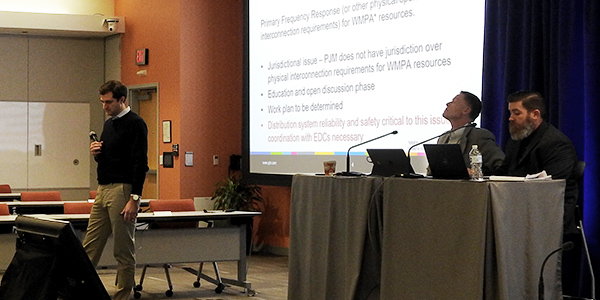By Rory D. Sweeney
Low Frequency Update
VALLEY FORGE, Pa. — NERC is still analyzing the causes of the July 10 low-frequency event in the Eastern Interconnection, PJM’s Chris Pilong told attendees at last week’s Operating Committee meeting.
In working with 12 balancing authorities, NERC doesn’t believe it’s an error in the reported data. It appears to have been a “drift” in the frequency that was “significant” but happens every couple of years and was never near underfrequency relay tripping or system collapse, Pilong assured.
At the September OC meeting, PJM outlined recommendations to address the situation. (See “Recommendations from Frequency Drop,” PJM Operating Committee Briefs: Sept. 11, 2018.)
Quiet Month Operationally

Pilong said November was a very quiet month operationally aside from an emergency procedures drill. There was one reserve-sharing event with the Northeast Power Coordinating Council and 22 post-contingency local load relief warnings.
Both the on-peak and off-peak load-forecasting errors dropped from October, though they were slightly above the metric’s score for November 2017. The overall RTO error was 1.78%.
Staff presented a graph showing that load forecasting is often worse in many zones in the third quarter of the year during warm summer months. Staff used an example from July 20, 2017, when a storm in Commonwealth Edison’s zone reduced actual temperatures and load below day-ahead forecasts.
The balancing authority area control error (ACE) limit performance was 99.9% for the second straight month, above PJM’s 99% target. There were 15 excursions outside limits, which were down from October, and 30 minutes total outside of limits, also down from the prior month.
DER Subcommittee

PJM’s Scott Baker confirmed during his update on the Distributed Energy Resources Subcommittee that it is considering primary frequency response requirements for resources with non-FERC jurisdictional wholesale market participation agreements. But stakeholders “actually feel it’s a bigger issue” to hammer out frequency and voltage ride-through characteristics, Baker said.
In November, Planning Committee members endorsed a problem statement and issue charge to implement a new Institute of Electrical and Electronics Engineers standard on ride-through. (See “DER Ride-through,” PJM PC/TEAC Briefs: Nov. 8, 2018.)
PMUs to Planning
Load interests are keeping a close watch on a proposal from PJM to include installing or retrofitting phasor measurement units (PMU) as part of projects in the Regional Transmission Expansion Plan. The units would be used to back up monitoring of interconnection reliability operating limits (IROLs). PMUs are already used to detect oscillations in the system, along with improving post-event analysis and generator model validation. PJM also plans to use them in the future for system island and event detection, automated model validation and backup ACE monitoring.
PJM’s Shaun Murphy said the current IROL monitoring proposal is estimated to require 14 PMU installations and four modifications. The issue will be moved to the PC — which Murphy also addressed at its meeting last week — to develop a standard for new substations and major construction projects to include PMU installation for bus-voltage and line-flow monitoring.
Dave Mabry, representing the PJM Industrial Customer Coalition, asked who would own the PMUs. He said he wanted to ensure PJM is “spending wisely” rather than going on a “lark” with new technology that staff “want to play with.”
PJM’s Paul McGlynn said the incremental cost of adding the “thousands of dollars” that a PMU costs is “relatively inexpensive in the grand scheme of [the millions of dollars that building] a substation costs.” The intent would be to add them as part of baseline projects in the RTEP related to high-voltage lines.
“We’re not necessarily going after every low-voltage station,” he said.
Mabry said he was looking for validation of the need.
“I’m trying to make sure we’ve got a solid business case to justify the expansion of the PMUs,” he said.
OATF Base Case Parameters
PJM’s Robert Dropkin said the Operating Assessment Task Force (OATF) is building the base case for its study of the upcoming summer to identify thermal overloads and voltage-limit exceedances in N-1 analyses. The studies, which happen annually for the summer and winter peaks, also focuses on switching and off-cost requirements and looks to develop operating procedures for any issues discovered during the study.
The OATF, which consists of the transmission owners within PJM’s footprint, uses the most recent modeling from the Multi-regional Modeling Working Group (MMWG) and adds updates from individual TOs. Generator outages are calculated from the previous year and averaged with the two years previous to that. OATF members also select specific units to be put on outage based on historical or planned outages, or generators are simply reduced across the zone.
The base case will be developed in mid-February with analysis starting later that month. The final report is approved by the System Operations Subcommittee — Transmission in early May.



